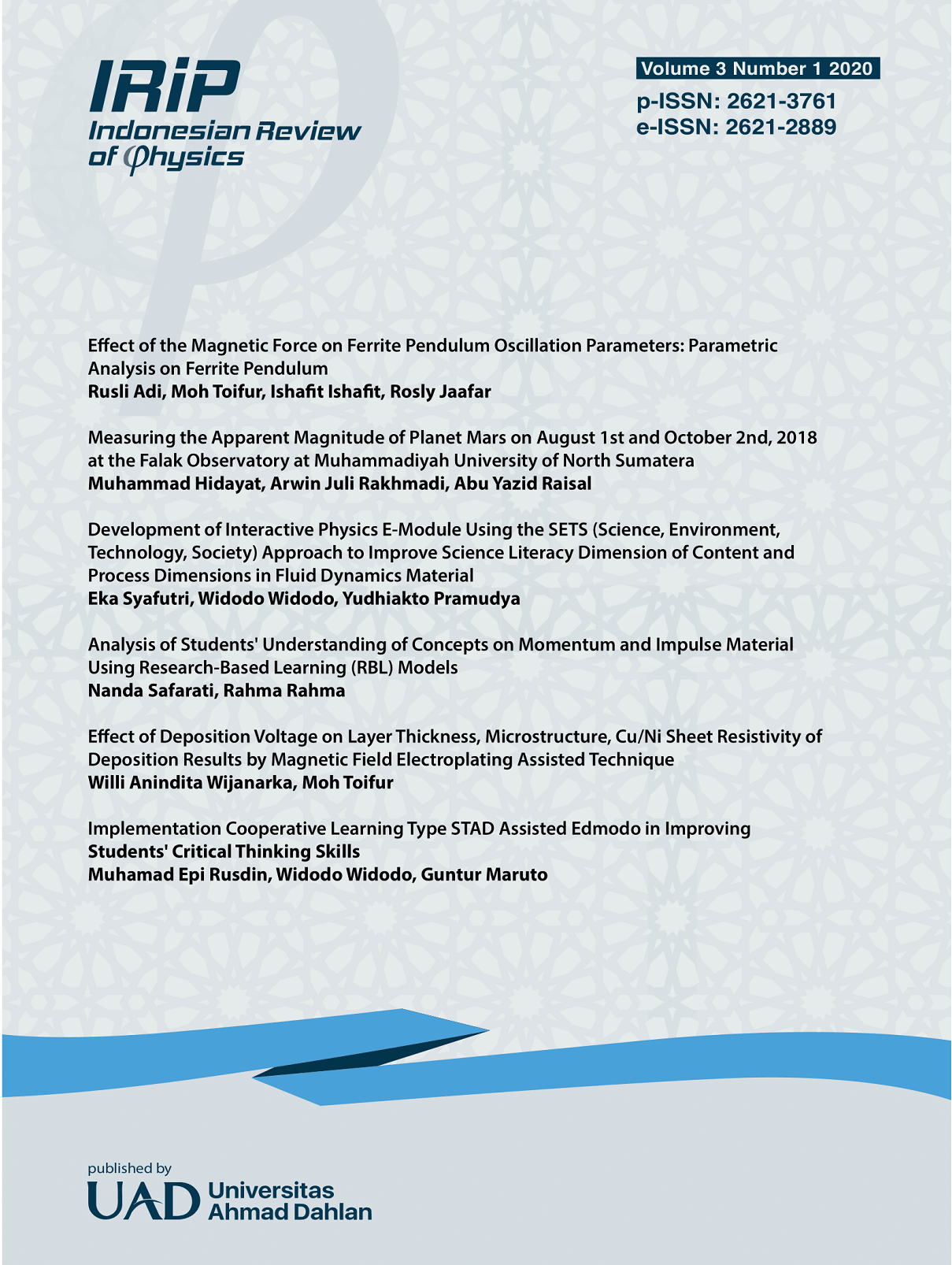Development of Interactive Physics E-Module Using the SETS (Science, Environment, Technology, Society) Approach to Improve Science Literacy Dimension of Content and Process Dimensions in Fluid Dynamics Material
DOI:
https://doi.org/10.12928/irip.v3i1.1691Keywords:
Dynamic fluid, E-Module, Science literacy, SETSAbstract
This development research produces interactive physic electronic products using the interactive physics SETS approach (Science, Environment, Technology and Society) in terms of presenting the components of illustration, language, and the suitability of the material. The validity results of the electronic module carried by experts and teachers develeop the average yield of 96.36% so it is feasible to use. The study design is pretest-posttest control group to see the improvement of literacy dimension process. Subject of the study consisted of two groups: the experimental group and the control group. The data collection formed by science literacy of dimension content and process is analyzed using MANOVA with significance level of 5%. The results showed that the electronic module using SETS approach significantly influence the improvement of science literacy dimension content and process.
References
[2] M. Arohman and D. Priyandoko, “Kemampuan Literasi Sains Siswa pada Pembelajaran Ekosistem,†2016.
[3] A. Binadja, Pedoman Praktis Pengembangan Bahan Pembelajaran Bervisi dan Berpendekatan SETS. 2007.
[4] P. Anna, “STEM Education: Inovasi dalam Pembelajaran Sains,†in Prosiding Seminar Nasional Pendidikan Sains, 2016, pp. 23–34.
[5] A. R. Hardisty et al., “BioVeL: A Virtual Laboratory for Data Analysis and Modelling in Biodiversity Science and Ecology,†BMC Ecol., vol. 16, no. 1, 2016, doi: 10.1186/s12898-016-0103-y.
[6] U. et al. Toharudin, Membangun Literasi Sains Peserta Didik. 2011.
[7] OECD, PISA 2015 Assessment and Analytical Framework: Science, Reading, Mathematic and Financial Literacy,. Paris: OECD Publishing.S. Verdu, Multi-user detection, Cambridge University Press, 2015.
[8] Rusman, “Belajar Berbasis Komputer, Pembelajaran Mengembangkan Profesionalisme Abad 21,†Bandung Alf., 2013.
[9] Gall, M. D, Gall, J. P, Borg, and W. R, Educational Research, An Introduction (Seventh Ed). Boston: Allyn and Bacon, 2003.
[10] L. Rizkita, H. Suwono, and H. Susilo, “Analisis Kemampuan Awal Literasi Sains Siswa SMA Kota Malang,†in Prosiding Seminar Nasional II, 2016, no. 2, pp. 771–781.
[11] N. G. Laderman, J. S. Laderman, and A. Antink, “Nature of Science and Scientific Literacy,†Int. J. Educ. Math. Sci. Technol. Int. Journla Educ. Math. Sci. Technol., vol. 1, no. 3, pp. 138–147, 2013.
[12] Sugiono, Metode Penelitian Kuantitatif, Kualitatif dan R & D, vol. 2. Bandung: Alfa Betta, 2013.
[13] R. R Hake, “Analyzing Change/Gain Scores,†Unpubl. URL http//www. physics. indiana. edu/~ sdi/AnalyzingChange-Gain. pdf, pp. 1–4, 1985.
Downloads
Published
Issue
Section
License
Authors who publish in IRiP agree to the following terms: Authors retain copyright and grant the IRiP right of first publication with the work simultaneously licensed under a Creative Commons Attribution License (CC BY-SA 4.0) that allows others to share (copy and redistribute the material in any medium or format) and adapt (remix, transform, and build upon the material) the work for any purpose, even commercially with an acknowledgment of the work's authorship and initial publication in IRiP. Authors are able to enter into separate, additional contractual arrangements for the non-exclusive distribution of the journal's published version of the work (e.g., post it to an institutional repository or publish it in a book), with an acknowledgment of its initial publication in IRiP. Authors are permitted and encouraged to post their work online (e.g., in institutional repositories or on their website) prior to and during the submission process, as it can lead to productive exchanges, as well as earlier and greater citation of published work (See The Effect of Open Access).















